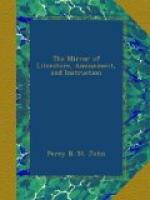’The prostrate South to the destroyer
yields
Her boasted titles and her golden fields;
With grim delight the brood of winter
view
A brighter day, and heavens of azure hue.
Scent the new fragrance of the breathing
rose.
And quaff the pendent vintage as it grows.’[8]
“In Greece, too, as well as Italy, the shoots of the vines are either trained upon trees, or supported, so as to display all their luxuriance, upon a series of props. This was the custom of the ancient vine-growers; and their descendants have preserved it in all its picturesque originality.[9] The vine-dressers of Persia train their vines to run up a wall, and curl over on the top. But the most luxurious cultivation of the vine in hot countries is where it covers the trellis-work which surrounds a well, inviting the owner and his family to gather beneath its shade. ‘The fruitful bough by well’ is of the highest antiquity.”
Passing over the Mulberry, Currant, Gooseberry, and the Strawberry, the account of the Egg Plant is particularly attractive; and that of the Olive is well-written, but too long for extract.
Among the Tropical Fruits, the Orange and the Date are very delightful; and equal in importance and interest are the Cocoa Nut and Bread Fruit Tree. In short, it is impossible to open the volume without being gratified with the richness and variety of its contents, and the amiable feeling which pervades the inferences and incidental observations of the writer.
A word or two on the embellishments and we have done. These are far behind the literary merits of the volume, and are discreditable productions. Where so much is well done it were better to omit engravings altogether than adopt such as these: “they imitate nature so abominably.” The group at page 223 is a fair specimen of the whole, than which nothing can be more lifeless. After the excellent cuts of Mr. London’s Gardener’s and Natural History Magazines, we turn away from these with pain, and it must be equally vexatious to the editor to see such accompaniments to his pages.
[Footnote 5: Picturesque Promenade round Dorking. Second Edit. 12mo. 1823, p. 258, 259.]
[Footnote 6: Ibid p. 143.]
[Footnote 7: The Alpenstock, by C.J. Latrobe, 1829.]
[Footnote 8: Gray’s Alliance of Education and Government.]
[Footnote 9: See the second Georgic of Virgil.]
* * * * *
SHAKSPEARE’S BROOCH.
[Illustration]
(TO THE EDITOR OF THE MIRROR.)




